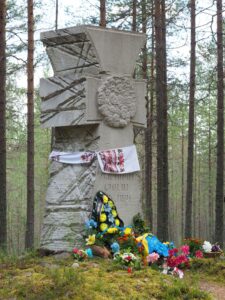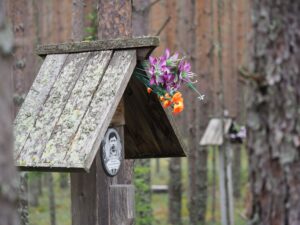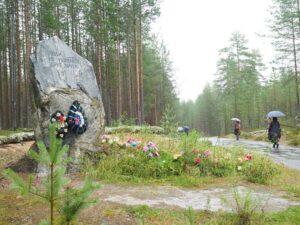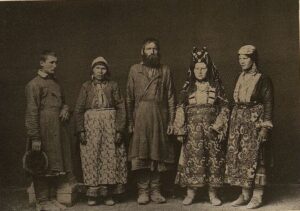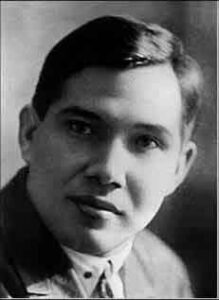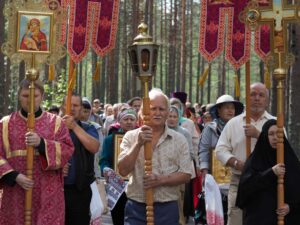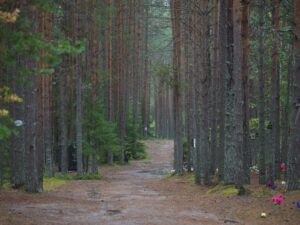Sergei Lebedev
The NKVD execution site as a symbol of Russia’s historical responsibility towards Ukraine, and a place of remembrance of Russian colonial violence.
From Sandarmokh to Bucha
In the days since 24 February 2022, any discussion of Russia’s future is inextricably linked to the responsibility – political, legal, and moral – for its attack on Ukraine. However, in its historical dimension, one might say this responsibility should be more broadly interpreted to include the responsibility towards other nations who were previously or are currently subject to Russia’s colonial influence.
This is because Russia’s armed attack on Ukraine is not an extreme act of Commander-in-Chief Vladimir Putin’s madness. It is just an iteration of the imperial policy that Russia has pursued towards Ukraine and other conquered nations for centuries now. Even liberal-minded Russians are unaware of its systemic nature, its duration, and the significance of its long-term effects. One might even say that it is implicitly embedded in Russian high culture, seemingly traditionally opposed to authority – embedded as a hidden or overt superiority complex, linguistic arrogance, a learned or unconscious ignoring of the history and culture of neighbouring subject peoples, resulting in the ‘natural’ perception of their insignificance, secondary importance, non-subjectivity, and legitimate ties to Russia’s historical fate.
Looking at the Russian cultural landscape, shaped anew over the centuries, from this point of view, it would be extremely difficult to find any clue, starting point, or symbol on which to build the concept of responsibility towards Ukraine. True, the armed aggression launched in 2014, the annexation of Ukrainian territories, and the numerous serious war crimes committed by the Russian army call for accountability in and of themselves; this blood can neither be forgiven nor forgotten. But it is important, first of all, for the Russians themselves to acknowledge their continued criminal policy, and to recognise precisely its historical dimension, the heavy consequences passed down from generation to generation, which currently form the psychological basis for the heightened genocidal sentiments broadcast by propaganda.
Unfortunately, Russian history (in the form in which it is taught in public education institutions), which, by and large, tells the narrative of a ‘peaceful gathering of lands’, the voluntary unification of peoples under the auspices of the Russian state, serves the complete opposite purpose. Russian culture, with rare exceptions like Leo Tolstoy’s ‘Hadji Murat’, either leaves the colonial aspect out of consideration or exploits it uncritically, exalting the colonisers’ enlightenment mission of bringing development to ‘backward’ regions. With regard to Ukraine, specifically, then in Russia there are, for example, thousands of streets named after Ukrainian cities, hundreds of architectural structures (stations, bridges, buildings), whose names promulgate the idea of dependence and conflict-free unity.
A rare cultural sign of conflict on Russian territory, a symbol that speaks directly of past crimes against Ukraine, is located far in the Russian North, out of sight for most. A limestone monument in the form of a Cossack cross, erected in 2004 and bearing the inscription ‘To the Murdered Sons of Ukraine’, is located in the Karelian forest massif of Sandarmokh, where the NKVD executed more than 6,000 people between 1937-38.
Around 200 of the victims were prominent Ukrainian cultural figures* – writers, playwrights, and scholars, arrested in the 1930s on a number of interconnected cases fabricated by state security agencies (the most significant being the ‘Union for the Liberation of Ukraine’ and the ‘Ukrainian Military Organisation’ cases), accused, in one way or another, of Ukrainian nationalism, arrested and sent to Solovki to serve time, only to be re-convicted by the ‘troika’ and executed in 1937.
It is important to understand that Sandarmokh is a crime scene which is Soviet in form (an extrajudicial massacre), but imperial in content: the annihilation of a subject nation’s cultural elite, the bearers and propagators of the idea of cultural identity, independence, and emancipation.
Therefore, it is no coincidence that today’s Russian military propaganda language is actually identical to that which was used during the extrajudicial purges in the 1930s: in the Stalinist era, the expression ‘Ukrainian nationalist’ was in itself both a stigma and a sentence – and today Russian television broadcasts Ministry of Defence briefings about the ‘annihilation of Ukrainian nationalists’ with the same self-explanatory linguistic shamelessness: if one is a nationalist, one deserves to die.
Dmitriev’s Trial
Sandarmokh actually became widely known as a memorial site in Russia and abroad due to the sinister chain of events that began after Russia’s attack on Ukraine in 2014.
In the past, a large Ukrainian delegation had always come to Sandarmokh for the memorial ceremonies on 5 August. However, in the context of the war, the Ukrainian monument in Sandarmokh and the Ukrainian history of Sandarmokh turned into an indictment, into evidence of the recidivist, systemic nature of Russia’s repressive policy towards Ukraine.
In 2015, speaking at a ceremony in the presence of officials, Yury Dmitriev, Gulag researcher, head of the Karelian ‘Memorial’ and the man who, along with his colleagues, discovered Sandarmokh and turned it into a place of collective memory, spoke about the war in Eastern Ukraine. The undeclared, covert war waged by Russia. The victims of this war, whose names will be given back to us one day and made public – as in Sandarmokh – although their killers hope that they will be forgotten forever. I believe that after this speech, Dmitriev became a subject of an operational investigation conducted by security agencies, which led to his arrest in December 2016. He had crossed the red line: he had pointed out the monstrous continuity of the crime.
The charges – production of child pornography, and later, molestation of a minor – were carefully chosen so as not only to send Dmitriev to prison for a long time, but to irrevocably tarnish his name, and to ultimately discredit Sandarmokh as a place of memory and turn people away from it.
At the federal level, authorities used Dmitriev’s trial to discredit the Memorial and independent research into Soviet crimes as such; to cast a shadow over Sandarmokh and other places of mass executions; to question their authenticity; to intimidate activists.
Dmitriev’s trial lasted about five years; the courts changed, the trial restarted, and in the end Dmitriev, who had initially been acquitted, was sentenced to 15 years. Given his age and the sanitary conditions in Russian penal colonies, this is essentially legalised murder.
The Forest of Executed Nations
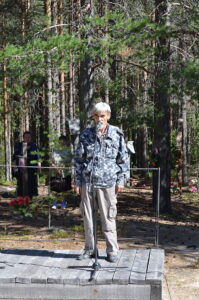
Yuri Dmitriev speaking at the Sandarmokh memorial site. Wikimedia Commons, Lic. CC BY-SA 3.0, Author: Visem
Paradoxically and, at the same time, sadly, it wasn’t until Yury Dmitriev’s arrest and the public campaign in his defence that the Russian liberal public ‘discovered’ Sandarmokh and its history for the first time.
Yury Dmitriev and his colleagues Irina Fliege and Vieniamin Joffe from the St. Petersburg ‘Memorial’ discovered Sandarmokh in 1997. It was one of those rare instances when it was not KGB/FSB who ‘declassified’ a special object to pre-empt researchers, but the researchers themselves who were able to locate and access archival data, which they then confirmed on site, despite the secrecy imposed by the regime.
Among those executed in Sandarmokh, 1,111 people, as it were, stand apart – the prisoners of the Solovki prison camp, the so-called ‘first-wave Solovkians’; victims of the Great Terror in Solovki, accused of counter-revolutionary activities while imprisoned.
It was the search for those people that eventually led Dmitriev and his colleagues to Sandarmokh; the murdered Ukrainian prisoners who are on the ‘Sandarmokh List’ compiled by Ukrainian historians and journalists were predominantly in this very group.
We can say that this ill-fated Solovki era was a kind of ‘time machine’, a reliquary of victims from previous repressive campaigns in the early and mid-1930s who endured their own, milder measure of cruelty.
If we were to generalise, the Ukrainians killed in Sandarmokh – writers, scholars, artists, and creators – collectively fell victim to the Soviet government’s shift away from the policy of indigenisation and the promotion of nation-building, towards the criminalisation of nationalism and the chauvinistic imperial agenda of the late twenties; a turn that tactically coincided with collectivisation and operations against former elites serving the Soviet government (like the ‘Vesna’ operation targeting tsarist officers, etc.).
As early as the mid 20th century, Ukrainian literary critic Yuriy Lavrinenko proposed the term ‘Executed Renaissance’ to refer to all Ukrainian creators who were executed in various places, sent to gulags, or silenced by circumstantial pressure.
However, Ukraine and Ukrainians were by no means the only USSR nation to suffer this way. In fact, every sovietised nation, large or small, has experienced its own ‘Executed Renaissance’; but, unfortunately, Russian collective memory exceedingly rarely singles out these atrocities as a distinctive type of crime with a genocidal accent; crimes against national cultures and languages at a vulnerable stage of development, crimes against the future of nations – personified by their leading cultural figures, linguistic geniuses, and masters of art. Here it is important to understand and accept the responsibility of Russian culture and Russian language, because these crimes were committed de facto for their benefit, given that as a result, what had been national was replaced by what was Russian, and what had been supra-national, by the universal.
Belarusians and Ukrainians, Tatars and Udmurts, Karelians – if we look closely at the ‘early’ period of repression in the late 1920s – early 1930s, we can find at least one mass trial, tailored by the OGPU (Joint State Political Directorate) according to a standard scheme, in every nation’s history: the trial of some non-existent Centre or Organisation that allegedly linked the national intelligentsia to counter-revolutionary goals on the basis of ‘bourgeois nationalism’. Convicted in such cases were not the pre-revolutionary, but the new Soviet cultural elite, who, believing the early Bolshevik promises of moving away from imperial chauvinism, began laying the foundations of national cultures: looking at ethnography, composing dictionaries and textbooks, reforming languages, writing poetry, prose, and drama, launching magazines – making up for lost time and what had not been created in their vernacular languages.
If one reads through the list of that ‘first Solovki wave’, then apart from Ukrainian names, which are striking in number, there are other names from the 1930s; the names of Tatar and Bashkir cultural figures, arrested in connection with the so-called ‘Sultan-Galiev Counter-Revolutionary Nationalist Organisation trial’; Belarusians sent to Solovki for participation in the Belarusian Peasants’ and Workers’ Community (BPWU) and the Belarusian National Centre; Finns from the Russian North, arrested in connection with the ‘Finnish General Staff trial’; Udmurts and Komi – victims of the ‘SOFIN’ (Union for the Liberation of Finnish Nationalities) trial. Their names and biographies are a bitter confirmation of the fact that the mass murder of Ukrainian cultural figures in Sandarmokh is not an exception, not an extreme, but rather a direct consequence of the Soviet leadership’s systematic policy aimed at suppressing the national development and identity of its subject peoples, which gave rise to dozens of the same type of repressive processes and dozens more crime scenes.
The fundamental difference in Sandarmokh’s case is that this memorial site originated in a unique way – thanks to Yury Dmitriev and his colleagues.
There is no single, typologically recognisable monument in Sandarmokh, and no wall where the names of the dead are inscribed. Rather, Sandarmokh evolved and was intentionally developed as a memorial forest, a forest of names on individual plaques, and individual national monuments erected by their respective countries and communities. Representatives of about 50 nationalities lie there, and over the years about 450 monuments and memorial signs have been erected throughout, including the Cossack cross itself, dedicated ‘To the Murdered Sons of Ukraine’.
One can say that Sandarmokh is divided along the national spectrum, and that it reveals what elsewhere remains invisible: not only the class, but also the colonial, national character of Soviet crimes, which is the legacy of the Russian Empire’s chauvinistic policy.
A Symbol of Colonial Violence
Sandarmokh is located in the North, near the city of Medvezhyegorsk in the Russian Republic of Karelia. The Ukrainian border is at least 1,200 kilometres away, about the same distance as Berlin is from Sofia or Naples. The area itself, having been in the orbit of Russian interest for centuries, long disputed by Russia and Sweden, was ultimately annexed and colonised by Russia. During the Civil War (1922), there was a mass uprising of Karelian-Finn nationals suppressed by the Red Army. Thus, Sandarmokh is in a territory whose indigenous population, firstly, was itself colonised, and, secondly, had little to do with the union-wide political goals of repression (the Karelians themselves suffered during collectivisation).
It can be said that Sandarmokh, as a topos, is the result of the encroachment of a foreign state’s will that chose it as a place of mass annihilation, destroying its historical innocence and condemning this part of the forest to become an execution site; a state will that came to the North in the form of gulags, in the form of a colossal project of internal colonisation (A. Etkind).
As such, it is worth noting that, in a way, the national monuments of Sandarmokh are not tied to this place. In a practical sense, the place was chosen by fate; the executioners could have adopted any other piece of land for their dirty deeds – the taiga is massive. Those monuments are, in a sense, cenotaphs, although they stand precisely at the scene of the crime.
That said, it was not the local taiga forest that suffered loss. The death of Ukrainian artists, Tatar writers, and Udmurt ethnographers orphaned and impoverished other countries – their native ones. It is there, in those distant cities, that monuments should be standing – monument-poems, monuments addressed directly to those who were deprived of their heritage and whose culture was diminished, to the living, to their descendants.
The monuments at Sandarmokh are a kind of map, a compact model, a universe of memory at a compression point, that will one day need to be unfolded on a national scale. To this day – and the wrongful war with Ukraine along with the refusal to acknowledge its historical and cultural subjectivity are the best example of this – Russia, and above all, Russian-speaking Russia, still does not realise to what extent imperial consciousness determines its political system, or to what extent institutionalised colonial violence is the unrecognised reality of today.
Two wars against Chechnya. War with Georgia. War with Ukraine. These are all evidence of Russia’s aggressive, predatory, and revanchist policy. But even in the minds of oppositionally inclined Russians, they are rather disparate episodes than successive chapters of the same story: the initial suppression of national emancipation within Russian state borders, then taking those repressive practices outside, from the soft ‘absorption’, or ‘erasure’ of Belarus’s national identity, to the attempted genocidal annihilation of Ukraine.
Admittedly, civilly responsible Russians still see wars as crimes. However, they pay much less attention to – and ask fewer questions about – the internal Russian practices of institutionalised suppression of national cultures, or the everyday cultural inequality that creates a chauvinistic accent, a flux of Russian, Russian-speaking culture, unnoticed by its speakers.
Today, soldiers from the Russian national republics are fighting in Ukraine, and, as military experts note, their participation is disproportionately substantial. In fact, Russia cynically uses the colonised nations – Tatars, Buryats, Kalmyks, Chechens, and many others – just as the former empires used conquered peoples for their armies (French Zouaves or British Gurkhas).
The difference lies in the fact that according to official propaganda, the Russian national republic soldiers are fighting for the Russian-speaking population of Ukraine who are oppressed and deprived of their linguistic rights.
This is a classic case of accusation in a mirror because it was in fact the national republics of the Russian Federation that lost much in 2018, when on Vladimir Putin’s suggestion the bill ‘on native languages’ was passed, de facto making the study of national languages in the schools of those respective regions voluntary (when previously it had been required). The bill quite obviously provokes linguistic migration – the rejection of local in favour of national – significantly infringing on cultural autonomy.
The situation is somewhat reminiscent to that of the USSR in the 1930s, the period of imperial reaction after the period of national ‘renaissances’ in the 1920s. In this sense, Sandarmokh not only preserves memory, but outlines the map of ongoing, smouldering conflicts, because the questions raised by the national cultural figures who were executed there – questions about national identity, autonomy, history, linguistic and political rights – have become extremist in today’s Russia, and dangerous from the state’s point of view, because they call into question the existing system of power, built on the absolute dominance of the Centre – fiscal, cultural, political, and linguistic.
These underlying conflicts continue to result in casualties; one such story draws a direct link between present and past, between today’s resistance to linguistic unification – and the distant Karelian Sandarmokh as a symbol of Soviet colonial violence.
Razin’s Case
In the early morning of 10 September 2019, in the city of Izhevsk, the capital of the Russian Republic of Udmurtia, deputies were on their way to a city council meeting.
They were met by a lone picketer with two posters. One read: ‘Do I have a Homeland?’ and the other: ‘If my mother tongue were to disappear tomorrow, then I would be ready to die today’. He was 79-year-old Albert Razin, a scientist, teacher, and Udmurt national movement activist. He had come out to protest the removal of the Udmurt language from the list of compulsory school subjects, in other words, against depriving Udmurtia of its language, and against the ongoing Russification.
The deputies who knew Razin greeted him peacefully. Razin alone knew that he was truly ‘ready to die today’. Razin and his assistant distributed leaflets to the deputies, in which the current national policy was called an extension of the ‘Stalinist policy of Russification’ of the Udmurts.
After handing out the leaflets, Razin gave a brief interview.
‘The Udmurt ethnic group is disappearing, and I cannot look on indifferently’, he says on the recording. ‘I would like all nations to be eternal, and all languages to be great ones – they should be cultivated, they should live and not die. If I do not protest, the deputies will not take any steps to save the Udmurt language and culture. And, consequently, the ethnos will die out. Decisive steps must be taken.’
After the interview Razin went home, changed his clothes, and prepared for self-immolation.
Returning to the square outside the city council, he set himself on fire. Attempts to extinguish the flames were unsuccessful. His body burned nearly one hundred percent, Razin died in the hospital a few hours later.
The internal instructions of the Soviet State Security Committee (KGB) recommend that people who commit self-immolation as an act of political protest be portrayed as crazy, mentally unstable persons. Those instructions were followed, for example, in the case of the Lithuanian student Romas Kalanta, who set himself on fire on 14 May 1972 on the main street in Kaunas, protesting the occupation and Russification of his homeland, leaving a note that read ‘the regime is solely responsible for my death’: a post-mortem examination declared him to be mentally ill.
They tried to do something similar in Udmurtia; to discredit Razin and his assistant through blogs and social media channels, presenting his self-immolation as an insane act, and creating the story that Razin was ‘set up by someone’. The Investigative Committee of the Republic opened a case called ‘Incitement to Suicide’, although the logic with which Razin appealed to the authorities clearly demonstrated that if anyone had driven the scientist to suicide, it was only the Russian state.
In contrast, sympathetic Udmurt activists wrote about Razin as a victim of the Russian state’s colonial policy. And, placing Razin, his life, his national mission, and his tragic death in a historical context, they spoke of another Udmurt, whose fate and death echoed in Albert Razin’s. This man was Kuzebay Gerd (his real name was Kuzma Pavlovich Chaynikov).
Kuzebay Gerd was an Udmurt writer, poet, and ethnographer. Born in 1898, after 1917 Gerd began actively creating national content using Soviet forms – became a demiurge of language and culture, one might say. He wrote lyrics, poems, and plays in Udmurt. He came out with books and school textbooks. He chaired the All-Udmurt Writers’ Association. He founded ‘Bolyak’, a society for the study of Udmurt culture.
It was this society, pressured by the higher-ups to dissolve as early as 1928, that became the ‘matrix’ for the SOFIN trial, fabricated by the Nizhny Novgorod Krai OGPU. The OGPU listed Gerd as one of the ‘leaders’ of the non-existent Union; in total, 28 people were arrested in connection with the case, including prominent Komi, Erzya, and Udmurt writers and scientists. The allegations were: ‘subversive, counter-revolutionary, nationalist, terrorist, and anti-Soviet activities aimed at tearing the territory of the Finno-Ugric republics away from the USSR and creating a bourgeois-democratic state under the protectorate of Finland’.
In the 1990s, astute researcher Konstantin Kulikov wrote in his book on the SOFIN case:
‘Officially, the Finno-Ugric peoples of Russia… are not considered to be repressed. In reality, however, they have been subject to the most severe repressions. The accusations of nationalism or the creation of anti-Soviet organisations under the protectorate of an officially declared enemy country – Finland – were not accusations against just one person, or even a group of people. They turned into an attack on the entire nation, from which the repressive authorities first extracted and executed the leaders, then the brightest representatives of the intelligentsia, the nation’s elite, while subjecting the rest of its people to unrelenting intimidation through preventive arrests and executions. As a result of those actions, people started judging their ethnic identity themselves, turning to mimicry or voluntarily assimilating in self-defence.’
In 1932 Gerd was arrested, convicted, and sent to Solovki. In Udmurtia, they fought against ‘Gerdovism’ – they seized Gerd’s works from libraries and searched for his other manuscripts. In 1937, Gerd, part of the ‘Solovki wave’, was taken to Sandarmokh and executed.
There is a strange proximity and similarity between the characters and personality types of Yury Dmitriev, the man who discovered the place where Kuzebay Gerd was killed, and Albert Razin, the scientist who continued Gerd’s work and sacrificed himself so that the Udmurt language could live on.
Razin set himself on fire; Dmitriev was sentenced to 15 years in prison on some of the most horrendous false charges. Their fates are irrefutable proof that Sandarmokh’s wounds still run deep and have not healed over time; that the new crimes committed by the Russian government are a direct legacy of an unrecognised, unspoken about, and unpunished past.
Fear of the National Question
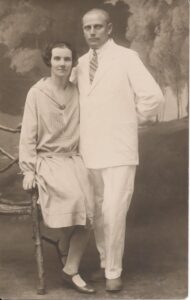
Jakob and Marta Palvadre, VaM F 2857:21, Valga Muuseum, http://www.muis.ee/en_GB/museaalview/2980430
In 1931, when the OGPU was still planning the SOFIN trial, the Soviet Ethnography journal published an article by Marta Palvadre, an Estonian researcher at the Museum of Ethnography, who accused Finnish scientists of catering to ‘Finnish fascism’ with their ‘bourgeois ethnography’, which aimed to scientifically substantiate the ‘unity of the Finno-Ugric peoples’ and make their annexation by Finland possible. Researcher Konstantin Kulikov strongly believes the article was ‘commissioned’; it set the stage for the ideological discourse on which the SOFIN case was subsequently built. The terrible irony of fate is that Palvadre was arrested in 1936, sent to Solovki, and in the autumn of 1937 was part of that first Solovki wave who were executed at Sandarmokh, alongside those who had become indirect victims of her article six years earlier.
Palvadre’s case is significant in that it reveals and confirms the ideological framework that is now being used by Russian propaganda against Ukraine. By this logic, any national movement aimed at emancipation from Moscow, from Russia, from the Centre, is inherently sinful, inherently guilty of fascism or Nazism, and draws its strength and ideas from them.
‘The black seed of fascism has spread throughout Kyiv, the mother of Russian cities’, Alexander Prokhanov, an ardent Ukraine hater and ‘Russkiy Mir’ (‘Russian World’) idealogue wrote in May 2014.
Today, Russia is waging a criminal war against Ukraine, calling the goal of the war ‘denazification’, and accusing Ukrainians of Nazism. The monuments at Sandarmokh testify that this is not at all a new propaganda tactic.
The perception of any kind of nationalism or desire for national self-determination as a sin, as an existential threat to the coercively created multi-component whole that is the Russian Federation, runs through Russia’s historical consciousness and political culture like a red thread. This perception has not been properly reflected upon or understood, and that is why the state’s propaganda is so effective, because it appeals to a kind of unconditional ideological reflex nurtured by generations that have lived ‘under the dome’ of this political system, in which the declared, folklorised ‘identity’ of nations was a facade of national politics behind which great power domination and repressive practices were hiding.
In the early 1990s, Russia, Russians, and Russian-speakers had a chance to appreciate their own dual situation: a nation-victim of the imperial project, which gave up its freedoms for the sake of an authoritarian state’s agenda, and a nation-aggressor, bringing unfreedom to others inside and outside the country; but fearing the red, communist revenge, Russian intellectuals overlooked the imperial revenge.
Today, when Russian troops have openly invaded Ukraine, and the names of Ukrainian cities and towns are becoming synonymous with new atrocities, the responsibility of Russian intellectuals – among other things – is not only to condemn the immeasurable evil being done to Ukraine and Ukrainians, but to consider and finally recognise the genealogy of this evil, which exists for a reason and is not irrational, and which is the ‘dark side’ of Russian social and political life.
To acknowledge at last that the crimes being committed against Ukraine today are obviously and directly connected with past crimes: with dekulakisation and the Holodomor, with the annihilation of Ukrainian cultural elites, including Sandarmokh, with the suppression of national armed resistance, and with the suppression of the national dissident movements in the 1960s, 1970s, and later.
To recognise that justice is demanded not only by the victims of Irpin, Bucha, and Mariupol, but also by the victims of other times, by all those who have been deprived of their culture, language, and life – in the name of the integrity of the Russian state.
The Stigma of Disintegration
The Soviet Union could not be reborn in Kyiv, Chisinau, or Tbilisi; only in Moscow.
Because only in Russia, with its age-old imperial heritage, does the existential fear of disintegration, the fear of secession, exist within its core. And every Russian authoritarian state, in all its iterations, is frozen, turned into bulwarks, into prison walls, in emanation of this fear.
This is why the conservative Russian consciousness will never be neutral towards an independent Ukraine, no matter how many neutrality pacts are signed. It will always remain a source of fear and an object of desire, because by simply existing, it proves that it is possible to live without Russia, outside of Russia. And this is not a disaster, as Vladimir Putin believes, but a norm.
Fear of falling apart. This fear is the Russian state’s dark genius, its inspiration. It is its historical fate, its destiny.
This is the fear of a guilty conscience, the fear of illegal, criminal possession, and the fear of karma. It feeds new crimes – otherwise, the old ones would have to be acknowledged, and history, culture, and identity would have to be reconsidered, and responsibility taken towards the absorbed, annexed nations.
Many people fell victim to this fear in the 20th century: to national deportations, exiles, purges, the suppression of national liberation movements, Russification… Periods of disintegration, such as the Civil War or perestroika, alternated with periods of revenge, as in after 1945 or in 2014; but the courageous resistance of Ukraine today, in 2022, proves that retaliation is now impossible – only conquest, destruction, and occupation remain.
The Ukrainian graves at Sandarmokh, and Sandarmokh itself as a place of long-standing historical memory, could become the starting point from which public consciousness begins to shift: from disdain and denial to the difficult acknowledgement of historical responsibility for the very nature and structure of the Russian state and society which made the war in Ukraine possible – and for all other recurring military, political, and cultural instances of colonial violence.
Ps
Language is power.
Language is a mystery.
The KGB department overseeing Dubravlag, a special Soviet gulag where political prisoners were kept, secretly recorded the conversations that took place in the visiting room there. Conversations in Russian were immediately recorded in operational files and used against the prisoners. Conversations in other languages, on the other hand, for example, in Ukrainian, Lithuanian, or Estonian, were sent to the KGB of those republics for decoding, requiring a special courier to carry the tape reels…
And so, the exchanges that took place between two people in the room remained – for several weeks, at least – a mystery.
Language served as the last defence, an alcove veil where there were no other defences or screens.
Language was a metaphor for the nocturnal darkness of love, a direct expression of intimacy; in language lived freedom, even if not for long, no longer than a butterfly’s lifespan.
Language is one’s ability to read another person; language is also the ability not to be read by others.
In his now infamous poem ‘On the Independence of Ukraine’, Joseph Brodsky behaves not like a poet, but like a language suzerain who learns that his province has been taken from him: he feels a personal insult, a damage to his personal power.
And so, for those of us who write and speak Russian today it is extremely important that the Ukrainian graves at Sandarmokh speak out; that the terrible fate of the creators of the Ukrainian language executed there, the terrible account of a future that was stolen, be recognised as part of the ongoing tragedy of Russian claims to Ukraine, as a perpetuation of today’s crimes, and as a call for accountability.
*Unfortunately, the limited scope of this article makes it impossible to list all the names of the Ukrainian cultural figures who were killed in Sandarmokh. Among them were – Mykola Zerov, a poet and translator, and one of the leaders of the group of ‘neoclassicists’ who took it upon themselves to translate the most important works of world literature into Ukrainian; Zerov translated the ‘Aeneid’ in the Solovki prison camp; Valerian Pidmohylnyi, writer, and author of the modernist novel ‘The City’ (recently published in Germany); geographer Stepan Rudnitsky, who pioneered the political geography of Ukraine; innovative theatre director Les Kurbas; poet and translator Marko Voronyi, son of the writer, director, politician, and one of the founders of the Central Rada, Mykola Voronyi, who was executed a year later in Odessa; writer and politician Antin Krushelnytskyi, former Minister of Education of the Ukrainian People’s Republic; writer and playwright Mykola Kulish; politician and publicist Mikhail Lozinsky; Yury Ozerskyi, USSR Glavnauka chairman; Dmitry Rovinsky, founder of the Ukrainian theatre ‘Zhovten’ in Leningrad; political and religious activist Volodymyr Chekhivsky; writers Hryhorii Vakar, Vasyl Atamanyuk-Yablunenko, Mikhailo Kozorez, Ivan Dorozhny-Minenko, Volodymyr Shtangey, Pavlo Filipovych, Myroslav Irchan, Mikhailo Kachanyuk, Hryhorii Kotlyarevsky, Mykhailo Yalovy, Oleksiy Yavorsky, Petr Krivenko-Matyenko, Oleksa Slisarenko, Valerian Polishchuk, Klym Polishchuk, Hryhorii Piddubnyy-Tolmachov, Hryhorii Epik, Andriy Panov, historians Oleksandr Badan-Yavorenko, Evgeniy Chernyak, Serhiy Vikul, Boris Pylypenko, academician Matvii Yavorskyi, Serhiy Hrushevsky, nephew of Mykhailo Hrushevsky, the Ukrainian history research titan who postulated Ukraine’s independent historical destiny, was arrested in 1930, and died soon after his release; philosopher Petro Demchuk, philologists Mykola Trofymenko and Ivan Shal.
All of them together – authors of texts, educators, editors, founders of literary schools and societies, mass media, publishing houses – form an entire generation that was killed and therefore unable to serve Ukraine in the way it could have. A special account is needed here: an assessment of what did not come to fruition, what could not be realised, and what was taken away from Ukraine’s future.
Sergei Lebedev – was born in Moscow in 1981. Both of his parents were geologists. Following their path at the age of fifteen, Lebedev spent eight seasons as a field worker in geological expeditions. Beginning in 2010, Lebedev wrote five novels dedicated to the theme of the hidden Soviet past, the impact of Stalin`s repressions and persecutions and their repercussions in modern Russian life. His fifth novel, Untraceable, is an intellectual thriller exploring the shadowy world of the Russian secret services. Lebedev`s books are translated into 22 languages and were shortlisted for major book prizes. He has lived in Germany since 2018. He unequivocally and openly speaks out against Russian aggression against Ukraine.
Reprint of an article from the journal “Osteuropa”: https://zeitschrift-osteuropa.de/hefte/2022/6-8/wenn-die-graeber-sprechen/
Translation from Russian: Monika Lutostanski




